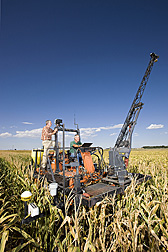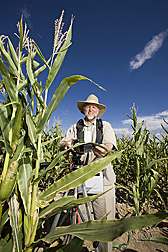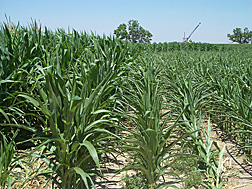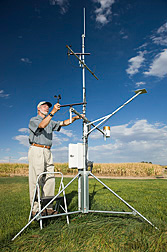Growing Crops and Saving Water in the West
Colorado is typical of much of the western United States in that the era of expanding irrigated agriculture has come to an end. In fact, the number of irrigated acres is declining.
The State of Colorado estimates that this decline will continue, because the current number of irrigated acres requires an amount of water that falls short of supplies by 10 percent.
Buy and Dry
Municipal and industrial users in cities along the Rocky Mountains are buying up farmland to get its water rights, then leaving the land idle—a practice called “buy and dry.”
An alternative to this is to have farmers limit their irrigation and sell or lease only the rights to their unused water, rather than sell the land as well. But that requires documentation of water saved that is sufficient for Colorado’s “Water Court” and approval by the State Engineer’s Office.
For this reason, Tom Trout, research leader of the Agricultural Research Service’s Water Management Research Unit (WMRU) in Fort Collins, Colorado, is measuring crop water-use efficiency not by the traditional measure of crop yield per drop of irrigation water applied, but rather by yield per drop of water actually taken in by the crop. That measure is called a “crop water productivity function.” It eliminates all water that does not enter a plant’s roots.
“This shows the actual strain on ground-water supplies, because water used by crops is effectively lost, while most unused rain and irrigation water returns to ground water or flows into streams for use downstream,” Trout says.
Trout is in the third year of a study to determine how much water four crops common to the High Plains region—corn, wheat, sunflower, and pinto beans—actually use. He is growing these crops in rotation and using drip irrigation on a 50-acre limited irrigation research farm near Greeley, Colorado. ARS operates the farm collaboratively with Colorado State University (CSU) at Fort Collins, which is about 30 miles northwest of Greeley.
Trout’s ARS colleagues in this study include agricultural engineer Walter Bausch and plant physiologists Dale Shaner and Lori Wiles, all at WMRU.
The data from this study will be used by the ARS Agricultural Systems Research Unit in Fort Collins to develop a computer “decision support” model to provide farmers with documentation of water savings and information on the economic viability of limited irrigation, crop by crop, to help farmers make decisions.
|
|
Water as a Crop
Regenesis Management Group, LLC, in Denver, Colorado, has signed a cooperative research and development agreement (CRADA) with both research units to create monitoring instruments and software for a web-based application being designed by the company and known as “SWIIM,” for Sustainable Water and Innovative Irrigation Management. This would allow farmers to treat water as a commodity, like corn, while sustaining economic and environmentally sound irrigation.
As part of the CRADA, the study will be expanded to include one of the main irrigation methods farmers use: running water down furrows between crop rows. ARS and CSU scientists have installed instruments on a 15-acre furrow-irrigated field to measure irrigation applications, runoff, and water percolating down through the soil. Regenesis Management Group will partly fund the research with the goal of developing the underlying science to legally support water transfers.
Will Limited Irrigation Save Water?
Farmers using limited irrigation do not give crops the full irrigation amounts needed for maximum yields. Instead, they use partial irrigations timed to critical growth stages.
Trout and colleagues designed the original study to see whether limited irrigation is best economically for each of the four crops and to help farmers with irrigation timing and amounts and other options. The four crops are being grown with six levels of irrigation, from full irrigation down to only 40 percent of full.
|
|
The research farm was set up to enable precision water control and accurate field measurements of water consumed. Use of drip irrigation eliminates the many variables found in furrow and overhead sprinkler irrigation. A series of meters and valves measures irrigation amounts.
A field weather station helps scientists predict the rate at which water is consumed—both transpired through plant leaves and evaporated from the soil surface. Actual soil water depletion is measured by moisture sensors down to 6 feet. Irrigation timing is based on both the predicted rates of crop water use and the soil water depletion measurements.
A “high boy” platform with digital cameras, infrared detectors, and an infrared thermometer is driven through the plots weekly to monitor crop growth and leaf temperature, an indicator of crop water deprivation.
So far, Trout has results for three seasons of limited-irrigation studies. For example, he found that corn yields varied from 210 bushels an acre for full irrigation down to 130 bushels for the lowest irrigation level.
|
|
Sell One Bushel of Corn or 2,500 Gallons of Water?
Trout found that the corn plants on 1 acre of land need to consume about 600,000 gallons of water—from irrigation and rain—to produce 200 bushels of corn. “After an initial amount of water to get the corn growing, the consumption rate stayed about the same through all six levels of irrigation—about 2,500 gallons per bushel of corn,” he says.
This flies in the face of the traditional belief that crops use water less efficiently as they get more of it. But in this experiment, Trout found that while that is true in terms of drops of irrigation water applied, it is not necessarily true in terms of drops of water consumed. In other words, there is no reduction in the amount of water corn takes in to produce each bushel, despite the reduction in the amount of irrigation water applied. This may make limited irrigation less attractive financially, at least for corn in this region.
“Corn farmers might do better financially to use full irrigation on a portion of their irrigated acres, rather than limited irrigation spread over all the acres,” Trout says. “They could then sell or lease the water rights on the nonirrigated acres. Another option would be to grow a different crop that requires less water, if the economics of limited irrigation work for that crop.”
These results are preliminary and may vary with changes in the timing of water applications, type of crop, or variety of corn.
The scientists plan to use computer models to test the results beyond the climate and soils on the research farm to a wide range of conditions throughout the central High Plains.
Irrigated agriculture in the central High Plains will continue and will help meet the food needs of a growing world population, but it must be carefully managed to maximize crop yields for each drop of water that passes through a plant.—By Don Comis, Agricultural Research Service Information Staff.
This research is part of Water Availability and Watershed Management, an ARS national program (#211) described at http://www.ars.usda.gov/research/programs.htm.
To reach scientists mentioned in this story, contact Don Comis, USDA-ARS Information Staff, 5601 Sunnyside Ave., Beltsville, MD 20705-5129; (301) 504-1625.
"Growing Crops and Saving Water in the West" was published in the August 2011 issue of Agricultural Research magazine.










